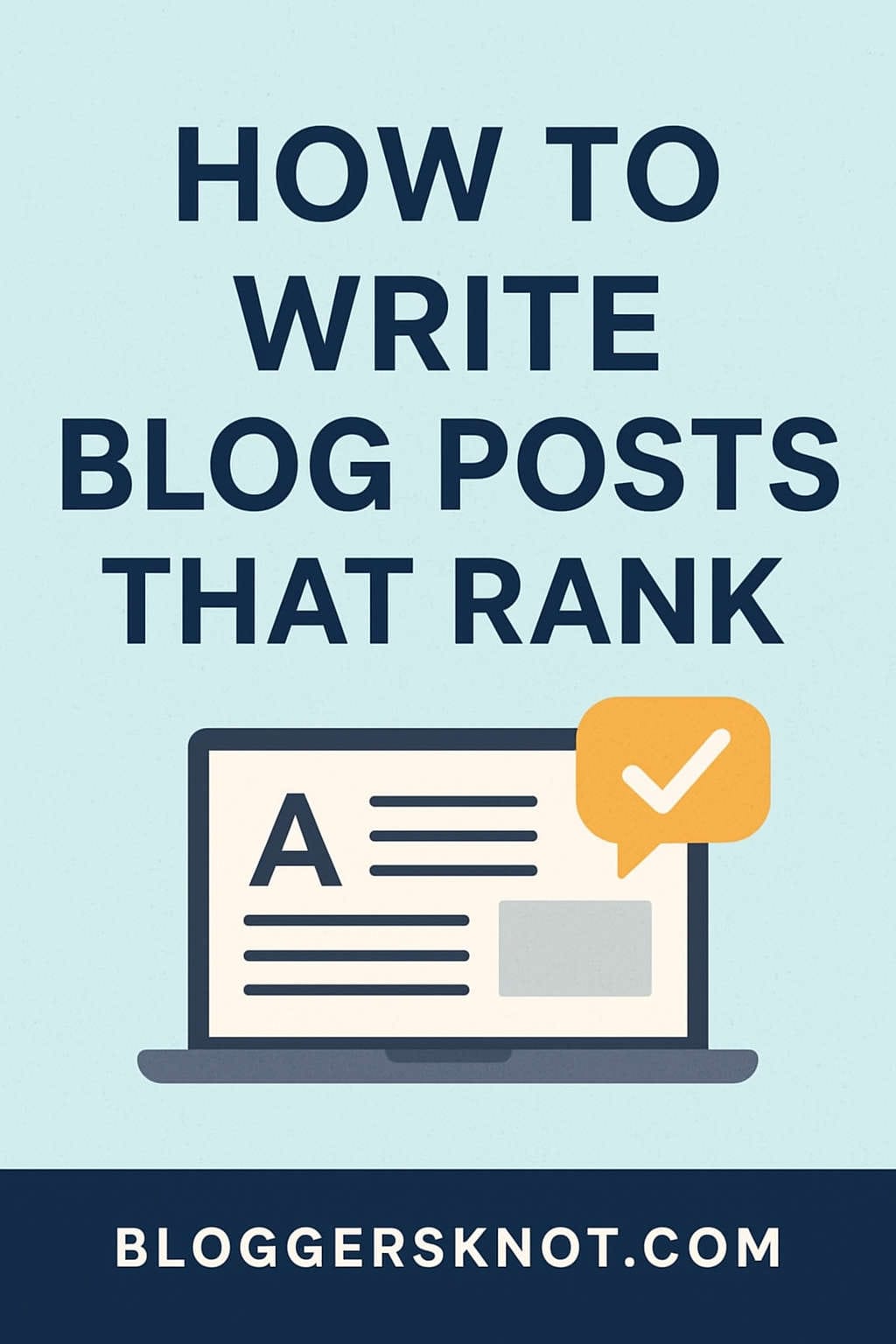Every blogger dreams of writing a post that not only gets published but also climbs search engine rankings, draws readers consistently, and continues generating traffic long after it’s written. Yet the reality is that most blog posts vanish into the endless noise of the internet. They’re written with good intentions, but without the right strategy, they rarely get noticed.
So what separates a blog post that ranks from one that disappears? It isn’t just about sprinkling in a few keywords or writing thousands of words. Blog posts that rank combine an understanding of search intent, strong storytelling, careful optimization, and a reader-first approach. They are written with both humans and algorithms in mind—but they always prioritize people.
This guide will walk you through everything you need to know about writing blog posts that actually rank in 2025. We’ll cover the foundations of SEO, the nuances of content structure, the psychology of headlines, and even the importance of ongoing maintenance. By the end, you’ll know exactly how to approach your next post with confidence and strategy.
Why Ranking Matters More Than Ever
Search engines remain one of the most powerful ways to attract readers to your content. Social media can be unpredictable, and paid ads stop working as soon as you stop paying. But when your blog ranks well in Google, you unlock a steady flow of organic traffic—people actively searching for what you’re writing about.
Ranking isn’t just about vanity metrics like page views. High-ranking posts:
- Build trust and authority in your niche.
- Attract backlinks naturally as others reference your work.
- Generate consistent leads or sales if you’re running a business.
- Keep working for you long after the initial publishing effort.
But to reach that point, you have to write with purpose and precision. Let’s break down how.
Step One: Start With Search Intent
Before you write a single word, you must understand why someone is searching for your topic. This concept, known as search intent, is the foundation of modern SEO.
Imagine two different searches:
- “Best cameras for travel blogging”
- “How to start a travel blog”
The first searcher likely wants product recommendations, comparisons, and pros and cons of different cameras. The second searcher wants step-by-step advice on launching a blog. If you confuse these intents—say, by writing a general guide when the reader wanted product reviews—you’ll lose their attention, and Google will notice.
Search engines measure how satisfied users are with your content. If people click on your result but bounce back quickly to try another, that tells Google your post didn’t meet the need. Over time, this can sink your rankings.
How do you figure out intent? Look at the first page of results for your target keyword. Are the top results tutorials, listicles, definitions, or product reviews? That’s a strong signal of what people (and Google) expect. Align your content with that format while still adding your unique voice.
Step Two: Choose the Right Keywords
Keyword research is still at the heart of SEO—but it has evolved. Gone are the days when stuffing a single phrase into your blog post ten times guaranteed rankings. Today, keyword research is about understanding the language your audience uses and targeting terms that are both realistic and impactful.
A common mistake is targeting keywords that are far too broad. For example, trying to rank for “shoes” would pit you against global retailers with enormous authority. Instead, long-tail keywords—more specific, longer phrases—are often more effective.
Think of phrases like:
- “Best trail running shoes for flat feet”
- “Affordable wedding shoes under $100”
These may get fewer searches, but they attract highly motivated readers who are more likely to click, stay, and convert.
There are plenty of tools to help with keyword research, from paid platforms like SEMrush, Ahrefs, and Moz to free ones like Google Keyword Planner or Ubersuggest. But don’t underestimate intuition. Ask yourself: If I were searching for this information, what exact words would I type? Often, that simple exercise reveals powerful opportunities.
Step Three: Craft Headlines That Compel
Your headline is your blog post’s handshake—it’s the first thing readers and search engines see. A weak headline means fewer clicks, which means less traffic, which ultimately means lower rankings.
A strong headline does three things:
- Includes the target keyword naturally.
- Clearly communicates the value or benefit of reading.
- Sparks curiosity without resorting to clickbait.
Compare these two headlines:
- “Blog SEO Tips”
- “How to Write Blog Posts That Rank in 2025: Proven SEO Strategies”
The second one is far more compelling. It promises updated information, includes the target keyword, and sets the expectation that readers will leave with practical strategies.
Another tip: test your headlines before publishing. You can use tools like CoSchedule’s Headline Analyzer or simply ask colleagues which version they’d be more likely to click.
Step Four: Write an Engaging Introduction
Once your headline earns the click, your introduction has one job: convince the reader to stay. Too many bloggers lose readers in the first paragraph by being vague, dull, or overly self-promotional.
A great introduction usually does three things:
- Identifies the reader’s problem. Show them you understand why they searched for this topic.
- Builds empathy. Let them know they’re not alone in facing this challenge.
- Previews the solution. Promise that by the end of the article, they’ll have clear answers.
For example, if your post is about ranking blog posts, an opening line like:
“If you’ve ever poured hours into writing a blog post only to watch it sit quietly with no traffic, you know how frustrating it feels.”
This connects immediately with the reader’s pain point. From there, you lead them toward the solution your post offers.
Step Five: Structure for Readability and SEO
Even the most valuable information won’t rank—or get read—if it’s buried in walls of text. Blog posts need to be structured for both humans and search engines.
Use subheadings (H2s and H3s) to break content into digestible chunks. Not only does this make reading easier, but it also signals to Google what each section is about. Keep paragraphs short—two to four sentences is ideal—and use white space strategically.
Visual elements like bullet points, block quotes, and images also improve readability. While you don’t want to overdo it, these small touches keep readers engaged and help them skim for the information they need.
Remember, most readers don’t read word-for-word. They scan. A well-structured article helps them find answers quickly, which increases satisfaction and keeps them on your page longer—a key ranking factor.
Step Six: Write for People, Not Just Algorithms
It’s tempting to write with SEO in mind first, but Google’s algorithm has advanced to the point where helpful, human-first content always wins.
Instead of forcing in keywords, write as if you’re explaining the topic to a friend over coffee. Use natural language, share examples, and include personal insights. If a sentence feels awkward because of keyword stuffing, rewrite it.
Search engines now look at engagement signals:
- Do readers spend time on the page?
- Do they scroll through most of the content?
- Do they click on internal links to explore more?
These are all indicators that your content is helpful. So while SEO matters, authenticity, clarity, and usefulness matter more.
Step Seven: Add Depth Without Fluff
There’s often debate about whether long-form or short-form content performs better. The truth is, depth is more important than length.
A 3,000-word blog post that rambles without offering substance won’t perform as well as a 1,500-word article that answers the query thoroughly. At the same time, if your post is too shallow, readers may leave to find better answers elsewhere.
The best-performing blog posts tend to cover a topic comprehensively. Anticipate follow-up questions your reader might have and answer them in your post. Provide examples, case studies, or even quick step-by-step instructions where appropriate. The goal is to become a one-stop resource.
Step Eight: Optimize Smartly
SEO optimization should feel like seasoning, not the main course. Here are elements to focus on:
- Title tag: Include your target keyword naturally.
- Meta description: Write a compelling summary under 160 characters. While not a direct ranking factor, it impacts click-through rates.
- Internal links: Link to other relevant posts on your blog to keep readers engaged.
- External links: Reference credible sources to build trust.
- Images and alt text: Use visuals to support your points, and always include descriptive alt text.
- URL structure: Keep it short, descriptive, and keyword-rich.
What you shouldn’t do is over-optimize. Too many keywords, forced phrasing, or unnatural linking patterns can actually hurt rankings. Balance is key.
Step Nine: Aim for Featured Snippets
In today’s search landscape, the top spot isn’t always enough. Featured snippets—the answer boxes at the top of search results—attract a huge share of clicks.
To optimize for snippets, identify common questions your audience asks. Then provide clear, concise answers in your blog post. For example, if you’re writing about blog SEO, include a short paragraph answering: “What is search intent?” in plain language.
Formatting also helps. Numbered steps, tables, and short definitions are all snippet-friendly. Even if you don’t capture the snippet immediately, optimizing your post for this format increases your chances.
Step Ten: Build Authority Over Time
Google doesn’t just rank pages; it ranks websites. That means your overall authority influences how well individual posts perform.
Authority comes from:
- Publishing consistently high-quality content.
- Earning backlinks from reputable websites.
- Building engagement and trust with readers.
This is why blogging is a long-term game. One great post can rank, but a library of valuable content builds momentum. Over time, search engines recognize your site as an authority in your niche, making it easier for all your posts to rank.
Step Eleven: Update and Refresh Content
SEO isn’t set-and-forget. Even the best-ranking posts can slip over time as new content appears or information becomes outdated. Regular updates keep your posts relevant and signal freshness to Google.
When updating, consider:
- Adding new statistics or case studies.
- Expanding on sections that are thin.
- Updating screenshots or examples.
- Improving formatting for readability.
- Refining your headline or meta description.
Think of your blog as a living library. The more you maintain it, the more valuable it becomes over time.
Step Twelve: Promote Your Content
Even the most optimized post won’t rank if no one sees it. Promotion is how you give your content an initial push.
Share your post across social media platforms, include it in newsletters, and consider collaborating with other creators. Guest posting or appearing on podcasts can also drive traffic to your blog.
The early traffic you generate helps Google gauge whether your content resonates with readers. If people engage, share, and link to it, that momentum can boost your rankings.
Step Thirteen: Focus on User Experience
Google pays attention to user experience (UX). A blog post that loads slowly, looks cluttered, or doesn’t work on mobile devices won’t rank well.
Make sure your site is:
- Mobile-friendly. Most searches now happen on mobile.
- Fast-loading. Compress images, use reliable hosting, and minimize plugins.
- Cleanly designed. Simple fonts, plenty of white space, and intuitive navigation.
A smooth experience keeps readers on your site longer, which improves engagement signals and rankings.
Step Fourteen: Measure, Learn, and Improve
Finally, treat ranking as an ongoing process of learning and adjusting. Use tools like Google Analytics and Google Search Console to track performance.
Pay attention to:
- Which keywords bring the most traffic.
- How long readers stay on each post.
- Which posts generate the most conversions or shares.
If a post isn’t performing, don’t abandon it. Refine it. Sometimes even small changes—like adding a new section or improving the headline—can move a post from page two to page one.
Bringing It All Together
Writing blog posts that rank is both a skill and a process. It requires balancing creativity with strategy, writing for people while respecting algorithms, and committing to long-term improvement.
At its core, the formula looks like this:
- Understand what your audience is searching for.
- Write content that thoroughly answers their questions.
- Structure it for readability and optimize it for SEO.
- Promote it strategically and maintain it over time.
But the real secret? Care about your readers. When you write with empathy, clarity, and purpose, you naturally create the kind of content search engines want to reward.
Ranking doesn’t happen overnight, but with patience and persistence, your blog can become a trusted resource that attracts traffic for years to come.
So the next time you sit down to write, don’t just think about getting words on a page. Think about crafting a post that deserves to rank—one that helps real people and earns its place at the top.






